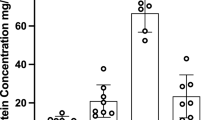Abstract
In an effort to develop an animal model of hyperpipecolatemia, the uptake of pipecolic acid (PA) in the brain and changes of PA levels in serum following administration ofd,l-PA were studied in the mouse using a new sensitive HPLC-EC method. Following i.p. injections (250 mg/kg) to adult male mice, the brain concentration peaks at 5–10 min (40 nmol/g). The level remains relatively stable up to 5 hrs and then declines slowly to 24 hrs. In serum, the level of PA increases rapidly to reach the maximum value at 10 min and then decreases rapidly in the first hour and continues to decline more slowly to 24 hrs. The net uptake of PA following administration of various amounts ofd,l-PA is saturable at low doses (3.9–15.6 mg/kg), and it increases linearly at higher doses in a dose-dependent manner up to the maximum dose (500 mg/kg) used in the present study. Kinetic analysis suggests the presence of two kinds of transport systems. These findings are in good agreement with the previous results usingd,l-[3H]PA in the mouse (7) andl-[14C]PA in the rat (13). There were no significant differences between uptake ofd-pipecolic acid andl-pipecolic acid (250 mg/kg, i. p., 10 min), suggesting the absence of stereospecificity for PA uptake in the mouse brain. Developmental changes in net brain uptake of PA following injections ofd,l-PA (250 mg/kg, s.c., 10 min) showed an age-dependent decrease which continues until adult levels are reached at four weeks after birth. The results suggest that the blood brain barrier (BBB) for PA is completed during the first month of life. Following administration ofd,l-PA (250 mg/kg, s.c.) to pregnant mice during the period 19–21 days of gestation, PA level increases in fetal brain to a maximum value at 2 hrs (420 nmol/g). This level is unchanged during 24 hrs. The maximum level of PA in fetal serum is reached at 30 min to 1 hr. The level gradually decreases after 1 hr over 24 hrs. These results indicate that PA taken up by the placenta and into the brain is transported from the fetal circulation. Our results also demonstrate that a higher amount of PA is taken up by the fetal than the adult brain. This finding is important in order to develop an animal model of hyperpipecolatemia in which high brain levels of PA should mimick those of human hyperpipecolatemic patients. Our results strongly support the hypothesis that high levels of PA present in brain during fetal life may exert a devastating effect on the development of the human CNS in hyperpipecolatemic children.
Similar content being viewed by others
References
Nomura, Y., Schmidt-Glenewinkel, T., andGiacobini, E. 1978. In vitro formation of piperidine, cadaverine and pipecolic acid in chick and mouse brain during development. Dev. Neuroscience 1:239–249.
Schmidt-Glenewinkel, T., Nomura, Y., andGiacobini, E. 1977. The conversion of lysine into piperidine, cadaverine and pipecolic acid in the brain and other organs of the mouse. Neurochem. Res. 2:619–637.
Gatfield, P. D., Taller, E., Hinton, G. G., Wallace, A. C., Abdelnour, G. M., andHaust, M. D. 1968. Hyperpipecolatemia: a new metabolic disorder associated with neuropathy and hepatomegaly: a case study. Can. Med. Assoc. J. 99:1215–1233.
Danks, D. M., Tippett, P., Adams, C., andCampbell, P. 1975. Cerebro-hepato-renal syndrome of Zellweger. J. Pediatrics 86:382–387.
Kelly, R. I., andMoser, H. W. 1984. Hyperpipecolic acidemia in neonatal adrenoleukodystrophy. Amer. J. Med. Genetics 19:791–795.
Goldfischer, S., Collins, J., Rapin, I., andColtoff-Schiller, B. 1985. Peroxisomal defects in neonatal-onset and x-linked adrenoleukodystrophies. Science 227:67–70.
Nishio, H., andGiacobini, E. 1981. Brain uptake of pipecolic acid, amino acids and amines following intracarotid injection in the mouse. Neurochem. Res. 6:835–845.
Nishio, H., Ortiz, J., andGiacobini, E. 1981. Accumulation and metabolism of pipecolic acid in the brain and other organs of the mouse. Neurochem. Res. 6:1241–1252.
Nishio, H., Giacobini, E., Ortiz, J., andGutierrez, M.d.C. 1983. Accumulation and metabolism of pipecolic acid in the developing brain of the mouse. Dev. Brain Res. 6:107–112.
Kim, J. S., andGiacobini, E. 1984. Quantitative determination and regional distribution of pipecolic acid in rodent brain. Neurochem. Res. 9:1559–1569.
Charles, A. K., andChang, Y-F. 1981. Metabolism and uptake of L-pipecolic acid by brain and heart. Life Sci. 29:947–954.
Kim, J. S. andGiacobini, E. 1985. Pipecolic acid levels and transport in developing mouse brain. Dev. Brain Res. (In Press).
Charles, A. K., Chang, Y.-F., andMyslinski, N. R. 1983. Blood-brain barrier transport of L-pipecolic acid in various rat brain regions. Neurochem. Res. 8:1087–1096.
Oldendorf, W. H. 1973. Stereospecificity of blood-brain barrier permeability to amino acids. Amer. J. Physiol. 224:967–969.
Banos, G., Daniel, P. M., andPratt, O. E. 1978. The effect of age upon the entry of some amino acids into the brain, and their incorporation into cerebral protein. Dev. Med. Child Neurol. 20:335–346.
Sershen, H. andLajtha, A. 1976. Capillary transport of amino acids in the developing brain. Exp. Neurol. 53:465–474.
Cornford, E. M., Braun, L. D., andOldendorf, W. H. 1982. Developmental modulations of blood-brain barrier permeability as an indicator of changing nutritional requirements in the brain. Pediatr. Res. 16:324–328.
Greengard, O., andBrass, C. A. 1984. Developmental changes of cerebral phenylalanine uptake from severely elevated blood levels. Neurochem. Res. 9:837–848.
Giacobini, E., Nomura, Y., andSchmidt-Glenewinkel, T. 1980. Pipecolic acid origin, biosynthesis and metabolism in the brain. Cell. Mol. Biol. 26:135–146.
Giacobini, E. 1983. Imino acids of the brain, Vol. 3,in Lajtha, A. (ed.) Handbook of Neurochemistry.
Arneson, D. W., Tipton, R. E., andWard, J. C. 1982. Hyperpipecolic acidemia occurrence in an infant with clinical findings of the cerebro-hepato-renal (Zellweger) syndrome. Arch. Neurol. 39:713–716.
Brass, C. A., Isaacs, C. E., McChesney, R., andGreengard, O. 1982. The effect of hyperpheynylalaninemia on fetal development: a new animal model of maternal phenylketonuria. Pediatr. Res. 16:388–394.
Author information
Authors and Affiliations
Rights and permissions
About this article
Cite this article
Kim, J.S., Giacobini, E. Transport of pipecolic acid in adult and developing mouse brain. Neurochem Res 10, 1405–1415 (1985). https://doi.org/10.1007/BF00964981
Accepted:
Issue Date:
DOI: https://doi.org/10.1007/BF00964981




